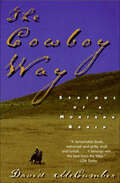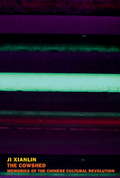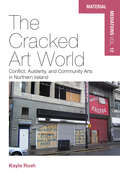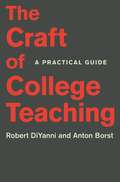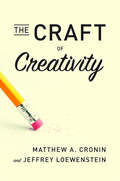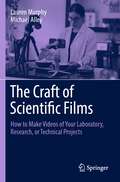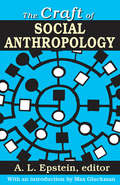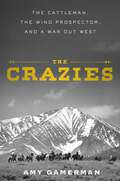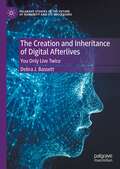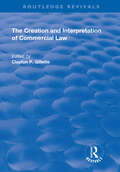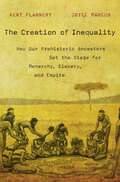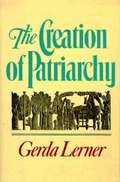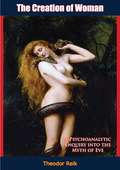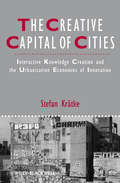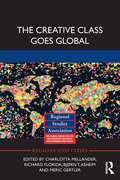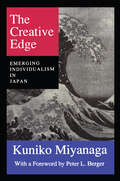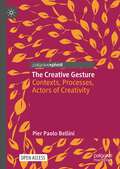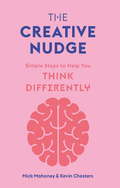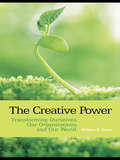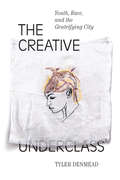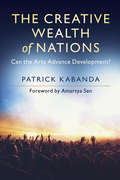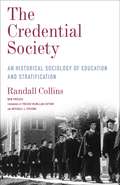- Table View
- List View
The Cowboy Way: Seasons of a Montana Ranch
by David McCumberIn February of his forty-fourth year, journalist David McCumber signed on as a hand on rancher Bill Galt's expansive Birch Creek spread in Montana. The Cowboy Way is an enthralling and intensely personal account of his year spent in open country—a book that expertly weaves together past and present into a vibrant and colorful tapestry of a vanishing way of life. At once a celebration of a breathtaking land both dangerous and nourishing, and a clear-eyed appreciation of the men—and women—who work it, David McCumber's remarkable story forever alters our long-held perceptions of the "Roy Rogers" cowboy with real-life experiences and hard economic truths.In February of his forty-fourth year, journalist David McCumber signed on as a hand on rancher Bill Galt's expansive Birch Creek spread in Montana. The Cowboy Way is an enthralling and intensely personal account of his year spent in open country—a book that expertly weaves together past and present into a vibrant and colorful tapestry of a vanishing way of life. At once a celebration of a breathtaking land both dangerous and nourishing, and a clear-eyed appreciation of the men—and women—who work it, David McCumber's remarkable story forever alters our long-held perceptions of the "Roy Rogers" cowboy with real-life experiences and hard economic truths.
The Cowshed
by Chenxing Jiang Zha Jianying Ji XianlinThe Chinese Cultural Revolution began in 1966 and led to a ten-year-long reign of Maoist terror throughout China, in which millions died or were sent to labor camps in the country or subjected to other forms of extreme discipline and humiliation. Ji Xianlin was one of them. The Cowshed is Ji's harrowing account of his imprisonment in 1968 on the campus of Peking University and his subsequent disillusionment with the cult of Mao. As the campus spirals into a political frenzy, Ji, a professor of Eastern languages, is persecuted by lecturers and students from his own department. His home is raided, his most treasured possessions are destroyed, and Ji himself must endure hours of humiliation at brutal "struggle sessions." He is forced to construct a cowshed (a makeshift prison for intellectuals who were labeled class enemies) in which he is then housed with other former colleagues. His eyewitness account of this excruciating experience is full of sharp irony, empathy, and remarkable insights into a central event in Chinese history.In contemporary China, the Cultural Revolution remains a delicate topic, little discussed, but if a Chinese citizen has read one book on the subject, it is likely to be Ji's memoir. When The Cowshed was published in China in 1998, it quickly became a bestseller. The Cultural Revolution had nearly disappeared from the collective memory. Prominent intellectuals rarely spoke openly about the revolution, and books on the subject were almost nonexistent. By the time of Ji's death in 2009, little had changed, and despite its popularity, The Cowshed remains one of the only testimonies of its kind. As Zha Jianying writes in the introduction, "The book has sold well and stayed in print. But authorities also quietly took steps to restrict public discussion of the memoir, as its subject continues to be treated as sensitive. The present English edition, skillfully translated by Chenxin Jiang, is hence a welcome, valuable addition to the small body of work in this genre. It makes an important contribution to our understanding of that period."
The Cracked Art World: Conflict, Austerity, and Community Arts in Northern Ireland (Material Mediations: People and Things in a World of Movement #12)
by Kayla RushThis book presents a nuanced view of Northern Ireland, a place at once deeply mired in its past and seeking to forge a new future for itself as a ‘post-post-conflict’ place within the context of a changing United Kingdom, a disintegrating Europe, and a globalized world. This is a Northern Ireland that is conflicted, segregated, and marginalized within modern Europe, but also hopeful and forward looking, seeking to articulate for itself a new place in the contemporary world.
The Craft of College Teaching: A Practical Guide
by Robert DiYanni Anton BorstThe essential how-to guide to successful college teaching and learningThe college classroom is a place where students have the opportunity to be transformed and inspired through learning—but teachers need to understand how students actually learn. Robert DiYanni and Anton Borst provide an accessible, hands-on guide to the craft of college teaching, giving instructors the practical tools they need to help students achieve not only academic success but also meaningful learning to last a lifetime.The Craft of College Teaching explains what to teach—emphasizing concepts and their relationships, not just isolated facts—as well as how to teach using active learning strategies that engage students through problems, case studies and scenarios, and practice reinforced by constructive feedback. The book tells how to motivate students, run productive discussions, create engaging lectures, use technology effectively, and much more. Interludes between chapters illustrate common challenges, including what to do on the first and last days of class and how to deal with student embarrassment, manage group work, and mentor students effectively. There are also plenty of questions and activities at the end of each chapter.Blending the latest research with practical techniques that really work, this easy-to-use guide draws on DiYanni and Borst's experience as professors, faculty consultants, and workshop leaders. Proven in the classroom and the workshop arena, The Craft of College Teaching is an essential resource for new instructors and seasoned pros alike.
The Craft of Creativity
by Matthew A. Cronin Jeffrey LoewensteinCreativity has long been thought of as a personal trait, a gift bestowed on some and unachievable by others. While we laud the products of creativity, the stories behind them are often abridged to the elusive "aha!" moment, the result of a momentary stroke of genius. In The Craft of Creativity Matthew A. Cronin and Jeffrey Loewenstein present a new way to understand how we innovate. They emphasize the importance of the journey and reveal the limitations of focusing on outcomes. Drawing on a wide range of scholarship, their own research, and interviews with professionals and learners who employ creativity in the arts, engineering, business, and more, Cronin and Loewenstein argue that creativity is a cognitive process that hinges on changing one's perspective. It's a skill that anyone can hone, and one that benefits from thinking with others and over time. Breaking new ground in the discussion about how we innovate, this book provides strategies that everyone can use to be more creative.
The Craft of Scientific Films: How to Make Videos of Your Laboratory, Research, or Technical Projects
by Michael Alley Lauren MurphyThis book, the first of its kind, helps scientists and engineers of all stages and disciplines share their work in a new way—with movies. Today, much of scientific communication is embedded in papers and presentations, but these documents don’t often extend outside of a specific academic field. By adding movies as a medium of communication, scientists and engineers can better communicate with their colleagues while also increasing their reach to students, professors, peers, potential collaborators, and the public. Scientific films help translate complex technical topics into more accessible and consumable messages. By following Lauren Murphy’s filmmaking formula – planning, shooting, and editing – readers will create their very own scientific films that look professional and polished. Using tools as simple as a smartphone, readers can develop short, personal stories with no cost or experience needed. This book will guide readers through all steps of the movie making process to a finished product. Readers will evolve their creative thinking skills and use their movies to improve classroom presentations, network across student organizations, present at conferences, recruit students for their labs, secure grant money, and more. Adding a movie to your body of work can be the tool that sparks interest in audiences to learn more—driving traffic to your publications, research projects, and websites. This book will help you develop new skills to become a better communicator while spreading your ideas and research to new audiences.
The Craft of Social Anthropology
by A.L. EpsteinIn social anthropology, as in other branches of science, there is a close relationship between research methods and theoretical problems. Advancing theory and shifts in orientation go hand in hand with the development of techniques and mutually influence one another. If the development of modern social anthropology owes much to its established tradition of fieldwork, it is also clear that the procedures that anthropological fieldwork should follow in the laboratory can never be prescribed in absolute terms nor become wholly standardized. Yet as anthropological analysis is refined, it becomes increasingly important that students in the field be aware of the need to collect basic kinds of data, and know how to set about doing so. In this volume, anthropologists who have worked closely together for many years at the Rhodes- Livingstone Institute for Social Research, Lusaka, and/or in the Department of Social Anthropology, University of Manchester, discuss within a common framework modern fieldwork methods as tools for examining a number of problems of current anthropological interest. Elizabeth Colson, J. Clyde Mitchell, and J. A. Barnes stress aspects of the role of quantification in social anthropology and indicate a range of problems that can be illuminated by the use of quantitative techniques. Equal importance is attached by all contributors to the collection and analysis of detailed case material, a topic explored in J. van Velsen's essay. A. L. and T. S. Epstein, V. W. Turner, and M. G. Marwick consider the kinds of data relevant to anthropological discussion in the fields of economics, law, ritual, and witchcraft, and the methods by which such material may be collected. The volume is introduced by Max Gluckman, former director of the Rhodes-Livingstone Institute and former head of the department of social anthropology and sociology, University of Manchester.
The Crazies: The Cattleman, the Wind Prospector, and a War Out West
by Amy GamermanA dazzling piece of narrative nonfiction about land lust and the American West, The Crazies tells the story of a wind farm that triggers a 21st century range war between a struggling fifth-generation rancher and the billionaires next door.Most locals in Big Timber, Montana learn to live with the wind. Rick Jarrett sought his fortune in it. Like his pioneer ancestors who staked their claims in the Treasure State, he believed in his right to make a living off the land—and its newest precious resource, million-dollar wind. Trouble was, Jarrett&’s neighbors were some of the wealthiest and most influential men in America, trophy ranchers who&’d come West to enjoy magnificent mountain views, not stare at 500-foot wind turbines. And so began an epic showdown that would pull in an ever-widening cast of larger-than-life characters, including a Texas oil and gas tycoon, a roguish wind prospector, a Crow activist fighting for his tribe&’s rights to the mountains they hold sacred, and an Olympic athlete-turned-attorney whose path to redemption would lead to Jarrett&’s wind farm. A wildly entertaining yarn, the brawl over Crazy Mountain Wind would become a fight over the values that define us as Americans—and a window into how this country actually works. All the while, the most coveted rangeland in the West was being threatened by forces more powerful than anything one man could muster: dwindling snowpack, record drought, raging wildfires. The Crazies is a Western for a warming planet, full of cowboys and billionaires and billionaire cowboys. But it&’s also so much more. It&’s an exquisitely reported, ruggedly beautiful elegy for a vanishing way of life and a bighearted inquiry into how you can love a place so much you risk destroying it.
The Creation and Inheritance of Digital Afterlives: You Only Live Twice (Palgrave Studies in the Future of Humanity and its Successors)
by Debra J. BassettThis book explores how social networking platforms such as Facebook, Twitter, and WhatsApp ‘accidentally’ enable and nurture the creation of digital afterlives, and, importantly, the effect this digital inheritance has on the bereaved. Debra J. Bassett offers a holistic exploration of this phenomenon and presents qualitative data from three groups of participants: service providers, digital creators, and digital inheritors. For the bereaved, loss of data, lack of control, or digital obsolescence can lead to a second loss, and this book introduces the theory of ‘the fear of second loss’. Bassett argues that digital afterlives challenge and disrupt existing grief theories, suggesting how these theories might be expanded to accommodate digital inheritance. This interdisciplinary book will be of interest to sociologists, cyber psychologists, philosophers, death scholars, and grief counsellors. But Bassett’s book can also be seen as a canary in the coal mine for the ‘intentional’ Digital Afterlife Industry (DAI) and their race to monetise the dead. This book provides an understanding of the profound effects uncontrollable timed posthumous messages and the creation of thanabots could have on the bereaved, and Bassett’s conception of a Digital Do Not Reanimate (DDNR) order and a voluntary code of conduct could provide a useful addition to the DAI. Even in the digital societies of the West, we are far from immortal, but perhaps the question we really need to ask is: who wants to live forever?
The Creation and Interpretation of Commercial Law
by Clayton P. GilletteThis title was first published in 2003. This volume contains essays by prominent commentators on topics in commercial law. It addresses the increasing harmonization of international commercial law and the essays demonstrate different methodologies used in analysing commercial law, such as economic and jurisprudential approaches.
The Creation of Inequality: How Our Prehistoric Ancestors Set the Stage for Monarchy, Slavery, and Empire
by Kent Flannery Joyce MarcusOur early ancestors lived in small groups and worked actively to preserve social equality. As they created larger societies, however, inequality rose, and by 2500 BCE truly egalitarian societies were on the wane. In The Creation of Inequality, Kent Flannery and Joyce Marcus demonstrate that this development was not simply the result of population increase, food surplus, or the accumulation of valuables. Instead, inequality resulted from conscious manipulation of the unique social logic that lies at the core of every human group. A few societies allowed talented and ambitious individuals to rise in prestige while still preventing them from becoming a hereditary elite. But many others made high rank hereditary, by manipulating debts, genealogies, and sacred lore. At certain moments in history, intense competition among leaders of high rank gave rise to despotic kingdoms and empires in the Near East, Egypt, Africa, Mexico, Peru, and the Pacific. Drawing on their vast knowledge of both living and prehistoric social groups, Flannery and Marcus describe the changes in logic that create larger and more hierarchical societies, and they argue persuasively that many kinds of inequality can be overcome by reversing these changes, rather than by violence.
The Creation of Israeli Arabic
by Yonatan MendelThis book sheds light on the ways in which the on-going Israeli-Arab conflict has shaped Arabic language instruction. Due to its interdisciplinary nature it will be of great interest to academics and researchers in security and middle eastern studies as well as those focused on language and linguistics.
The Creation of Patriarchy (Women and History, Volume #1)
by Gerda LernerA major new work by a leading historian and pioneer in Women's Studies, The Creation of Patriarchy is a radical reconceptualization of the history of Western civilization that makes gender central to its analysis. The author argues that male dominance over women is the product of historical development and is not "natural" or biological and hence unchangeable. Therefore patriarchy as a system of organizing society can be ended by historical process. Lerner focuses on the contradiction between women's central role in creating society and their marginality in the meaning-giving process of interpretation and explanation. This fascinating paradox leads her to an exploration of nearly 2,600 years of human history and into the cultures of the ancient Near East, notably the Mesopotamian and ancient Hebrew societies, from whence the major gender metaphors of Western civilization are largely derived. Using historical, literary, archeological, and artistic evidence, Lerner traces the development of the leading ideas, symbols and metaphors by which partiarchal gender relations were incorporated into Western civilization. The book abounds with brilliant--and controversial--insights. Lerner propounds a startling new theory of class, showing the different ways in which class is structured for and experienced by men and women. She locates the origins of slavery in the earlier practice of "exchanging women" in marriage among tribes and shows that women of conquered tribes were the first slaves. In addition, the book contends that the exclusion of women from the role of mediator with the Divine--the dethroning of the fertility goddess and priestesses and the conceptualizing of men and women as essentially different creatures in Greek philosophy--represented the decisive turning points in the way gender is symbolized in Western civilization.
The Creation of Woman: A Psychoanalytic Enquiry into the Myth of Eve
by Theodor ReikTheodor Rеіk attempts to unravel the mystery of the Eve myth he bet gins with the two conflicting versions of the creation of woman in Genesis. In one passage, Genesis states that “God created man in his own image...male and female created he them,” and in a subsequent passage that God made Adam first and then created Eve out of Adam’s rib. Various interpretations offered by the rabbis, the poets, theologians, and Biblical scholars are examined, and the author shows how the statement that Eve was fashioned from Adam’s rib is still unexplained despite the efforts of higher criticism, anthropology, and the comparative science of religion.Dr. Reik offers a unique approach to the problem of the creation of woman, forming his own original and exciting assumptions. Using the findings of archaeology and anthropology as well as psychoanalysis, he explores the dark world of ritual, the tribal mysteries of primitive societies in which boys at puberty were supposed to die and be resurrected before they were permitted to marry Analytic comparison of the Eve myth with primitive ritual leads to the reconstruction of the primal form of the Biblical story and to the suggestion that it was not concerned with the birth of Eve but with the rebirth of the ancestral Adam. The author also suggests the possibility if a mother goddess in a still earlier phase: of the Hebrew religion.The late Theodor Reik is the author of Listening with the Third Еar, The Secret Self, Myth and Guilt, and Mystery on the Mountain.
The Creative Capital of Cities: Interactive Knowledge Creation and the Urbanization Economies of Innovation (IJURR Studies in Urban and Social Change Book Series #79)
by Stefan KrätkeThis book challenges the new urban growth concepts of the creative class and creative industries from a critical urban theory perspective. Critiques Richard Florida's popular books about cities and the creative class Presents an alternative approach based on analyses of empirical research data concerning the German urban system and the case study regions, Hanover and Berlin Underscores that the culture industry takes a leading role in conforming with neoliberal conceptions of labor markets
The Creative Class Goes Global (Regions and Cities)
by Richard Florida Bjørn T. Asheim Charlotta Mellander Meric GertlerCharlotta Mellander Meric GertlerThe whole landscape of research in urban studies was revolutionized by the publication of Richard Florida’s The Rise of the Creative Class in 2002, and his subsequent book entitled The Flight of the Creative Class has helped to maintain a decade-long explosion of interest in the field. While these two books examine the creative class in the context of the United States, research has emerged which investigates the creative class worldwide. This book brings together detailed studies of the creative class in cities across the globe, examining the impact of the creative class on growth and development. The countries covered include the United Kingdom, the Netherlands, Germany, Australia, China, Japan and Canada, in addition to the United States. Taken together, the contributions deepen our understanding of the creative class and the various factors that affect regional development, highlighting the similarities and differences between the creative class and economic development across countries. This book will be of great interest to scholars of economic geography, regional economics, urban sociology and cultural policy, as well as policy makers involved in urban development.
The Creative Edge: Emerging Individualism in Japan
by Kuniko MiyanagaForeign interpretations of Japan hinge, in large measure, on the notion of a simple homogeneous culture in which individuality is subsumed in collective enterprise. Such interpretations posit a society organized with incredible efficiency for economic superperformance, a society to be, at once, feared and emulated. In this volume, Kumiko Miyanaga argues that the simplistic view of monolithic collectivity is misleading, and that Japan is undergoing a period of social transformation in which traditional attitudes toward collectivism and individualism are shifting in favor of the latter.Miyanaga finds that individualism is flourishing most significantly in the area of entrepreneurship, thus invigorating an already vital Japan. The author begins with a carefully nuanced analysis of the traditional and contemporary relationship between individual and collective attitudes. Historically, individualism has been a quiet, peripheral subculture, a refuge for society's dropouts, expressing itself chiefly in religion and art, and influencing little in the way of social change.With the acceleration of economic and technological growth since the 1960s, some individualists on the periphery of the Japanese economy have gained a position strong enough to enable them to interact with the mainstream without losing their independence. In such areas as the fashion industry, in high technology, and in venture-capital firms, individualists who would never "make it" with Hitachi or Toyota suddenly find themselves with very lucrative economic opportunities.Miyanaga contends that there is now a mutual influence between the peripheral and mainstream sectors. As enterprises on the outskirts of the economy grow larger and more successful, they feel the pull of the old ideology, and, conversely, mainstream organizations have discovered that they need the "creative edge" that comes from the periphery. Just as the small Japanese entrepreneur dreams, at least occasionally, of being a Toyota, large corporations have come to realize the importance of individualism. This book offers an original and distinctive contribution to a very important debate over the future of the Japanese economy. It is a work of great fascination for social scientists, economists, and those seeking a social perspective on Japanese culture.
The Creative Gesture: Contexts, Processes, Actors of Creativity (Palgrave Studies in Creativity and Culture)
by Pier Paolo BelliniThis open access book offers a concise overview of the theories constructed within the various human sciences around the theme of creativity as a symbolic capacity to link things together: it manifests itself when the individual endowed with a certain type of intelligence encounters cultural and social conditions that enable them to develop that capacity to the maximum, rather than inhibiting it or diverting it to other fields where it is doomed to failure. Even the most intimate of human expressiveness is considered as a result of an active social relationality. Social dimensions of creativity (evaluation, primary socialization, motivation, leadership) and “creative processes” (creative attitude, creative gesture, divergent thinking, problem-solving capacity, interdisciplinary approach, randomness, algorithmic creativity) are also analysed.The book concludes by evaluating the course taken in the light of the relational theory of society: the development of creativity cannot beconceived outside of self-other relations.This book is the result of a translation done with the help of artificial intelligence. The text has subsequently been revised further by a professional copy editor in order to refine the work stylistically.
The Creative Nudge: Simple Steps to Help You Think Differently
by Kevin Chesters Mick MahoneyCreative thinking is something everyone can do. It's a way of looking at the world afresh, doing new things in new ways, taking risks. With The Creative Nudge, use 'nudge theory' to unleash your innate originality. A new behavioural science that reveals how small actions can have big impacts on our thinking, nudge theory powers this book. Using simple behaviour changes, retrain your brain and live a more creative and rewarding life.
The Creative Nudge: Simple Steps to Help You Think Differently
by Kevin Chesters Mick MahoneyCreative thinking is something everyone can do. It's a way of looking at the world afresh, doing new things in new ways, taking risks. With The Creative Nudge, use 'nudge theory' to unleash your innate originality. A new behavioural science that reveals how small actions can have big impacts on our thinking, nudge theory powers this book. Using simple behaviour changes, retrain your brain and live a more creative and rewarding life.
The Creative Power: Transforming Ourselves, Our Organizations, and Our World
by William E. SmithOver the last two decades a major focus of organization theory has been on understanding the dynamic relationships between individuals, organizations and their environments. This interest in dynamics, illustrated by systems, chaos, and complexity theory, is recorded in the works of Ackoff, Senge, and Stacey. This focus offers a new viewpoint on holism for practising leaders and theorists today. Building on this interest, Smith’s original text presents a new philosophical lens for helping leaders see the advantages of a more holistic approach to improving organizations. Specifically he: introduces the AIC (appreciation, influence, control) philosophy, model, and process of purpose-power relationships as a next step in the evolution of organization and systems theory traces its roots and evolution in organization theory and indicates its actual and potential contribution to that field translates the model into a transformative, strategic organizing process that can be used to organize at any level, in a way that will ensure the achievement of higher levels of purpose, at less cost and in less time than traditional organizational approaches. Developed and tested via his work for organizations including the World Bank, this revolutionary book will change the way organizations and individuals work.
The Creative Underclass: Youth, Race, and the Gentrifying City
by Tyler DenmeadAs an undergraduate at Brown University, Tyler Denmead founded New Urban Arts, a nationally recognized arts and humanities program primarily for young people of color in Providence, Rhode Island. Along with its positive impact, New Urban Arts, under his leadership, became entangled in Providence's urban renewal efforts that harmed the very youth it served. As in many deindustrialized cities, Providence's leaders viewed arts, culture, and creativity as a means to drive property development and attract young, educated, and affluent white people, such as Denmead, to economically and culturally kick-start the city. In The Creative Underclass, Denmead critically examines how New Urban Arts and similar organizations can become enmeshed in circumstances where young people, including himself, become visible once the city can leverage their creativity to benefit economic revitalization and gentrification. He points to the creative cultural practices that young people of color from low-income communities use to resist their subjectification as members of an underclass, which, along with redistributive economic policies, can be deployed as an effective means with which to both oppose gentrification and better serve the youth who have become emblematic of urban creativity.
The Creative Wealth of Nations: Can The Arts Advance Development?
by Amartya Sen Patrick KabandaDevelopment seen from a more holistic perspective looks beyond the expansion of material means and considers the enrichment of people's lives. The arts are an indispensable asset in taking a comprehensive approach toward the improvement of lives. Incorporating aspects of international trade, education, sustainability, gender, mental health and social inclusion, The Creative Wealth of Nations demonstrates the diverse impact of applying the arts in development to promote meaningful economic and social progress. <P><P>Patrick Kabanda explores a counterintuitive and largely invisible creative economy: whilst many artists struggle to make ends meet, the arts can also be a promising engine for economic growth. If nations can fully engage their creative wealth manifested in the arts, they are likely to reap major monetary and nonmonetary benefits from their cultural sector. Drawing from his own experience of the support music provided growing up amidst political and economic turmoil in Uganda, Kabanda shows us the benefits of an arts-inclusive approach to development in Africa, and beyond.<P> Proposes a new development paradigm that engages the arts in development, appealing to those interested in utilising not only monetary, but also non-monetary contributions to human progress.<P> Provides real-life global empirical examples to illustrate the author's argument for including the arts in development.<P> Features a foreword from Nobel Laureate and world-renowned philosopher and development economist Amartya Sen.
The Credential Society: An Historical Sociology of Education and Stratification (Legacy Editions)
by Randall CollinsThe Credential Society is a classic on the role of higher education in American society and an essential text for understanding the reproduction of inequality. Controversial at the time, Randall Collins’s claim that the expansion of American education has not increased social mobility, but rather created a cycle of credential inflation, has proven remarkably prescient.Collins shows how credential inflation stymies mass education’s promises of upward mobility. An unacknowledged spiral of the rising production of credentials and job requirements was brought about by the expansion of high school and then undergraduate education, with consequences including grade inflation, rising educational costs, and misleading job promises dangled by for-profit schools. Collins examines medicine, law, and engineering to show the ways in which credentialing closed these high-status professions to new arrivals. In an era marked by the devaluation of high school diplomas, outcry about the value of expensive undergraduate degrees, and the proliferation of new professional degrees like the MBA, The Credential Society has more than stood the test of time. In a new preface, Collins discusses recent developments, debunks claims that credentialization is driven by technological change, and points to alternative pathways for the future of education.
The Creed of the Conquering Chief, As Expounded by the Inspired Orator
by Albert Lewis Pelton"The Creed of the Conquering Chief, As Expounded by the Inspired Orator" by Albert Lewis Pelton is a powerful and motivational work that distills the principles of leadership and personal success into an inspiring creed. Pelton, a visionary thinker and accomplished author, delivers a compelling guide for those who aspire to achieve greatness and lead with confidence and conviction.In this seminal work, Pelton explores the characteristics and mindset of the "Conquering Chief," a metaphor for the ideal leader who triumphs over challenges and inspires others to reach their highest potential. Through a series of eloquent discourses, the "Inspired Orator" lays out a clear and actionable philosophy for success, rooted in timeless truths and practical wisdom.Pelton's writing is both poetic and pragmatic, making complex ideas accessible and relatable. He emphasizes the importance of self-belief, resilience, and vision in the pursuit of excellence. The book is structured around key themes such as the power of positive thinking, the necessity of decisive action, and the value of integrity and perseverance.Each chapter offers profound insights and practical advice, illustrated with vivid anecdotes and historical examples that highlight the universal applicability of the principles espoused. Pelton encourages readers to embrace their inner strength, cultivate a winning mindset, and lead with purpose and passion."The Creed of the Conquering Chief" is more than just a manual for personal development; it is a clarion call to rise above mediocrity and strive for greatness. Pelton's inspirational prose and timeless teachings resonate deeply, providing readers with the tools and motivation to transform their lives and the lives of those they lead.This book is an essential read for aspiring leaders, entrepreneurs, and anyone committed to personal and professional growth. Albert Lewis Pelton's "The Creed of the Conquering Chief" remains a beacon of inspiration, guiding readers on their journey to becoming triumphant leaders and masters of their own destiny.
